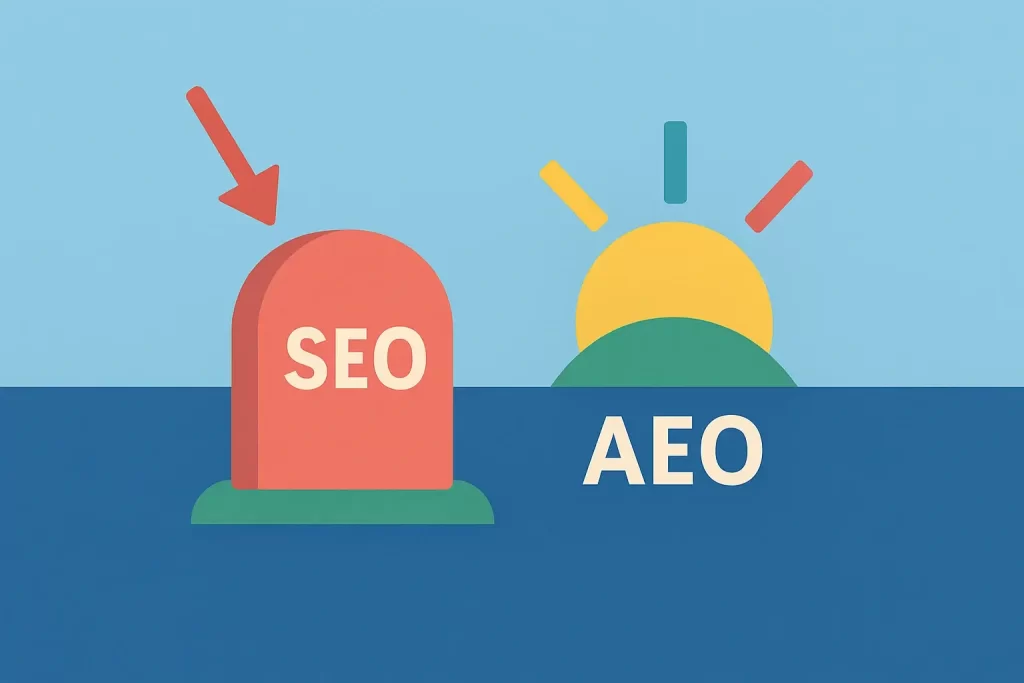SEO isn’t dead, but it has outgrown its old playbook. In 2025, search has changed. If you’re not optimizing for AI engines, you’re invisible. Today, it’s not just about being ranked; it’s about being referenced. That’s where AEO vs SEO becomes the question that defines your visibility.
What’s the Real Difference Between AEO and SEO?

Here’s the short version:
SEO helps you rank. AEO helps you show up in answers.
Traditional SEO chases a position on Page 1.
AEO (Answer Engine Optimization) makes sure you appear directly in Google AI Overviews, ChatGPT, Perplexity, and voice results.
| Criteria | Traditional SEO | AEO (Answer Engine Optimization) |
|---|---|---|
| Goal | Rank high in search results | Be quoted in AI answers and summaries |
| Focus | Keywords, backlinks, traffic | Structured content, clarity, and trust |
| Format | Long-form blogs, H2-rich text | TL;DRs, FAQs, tables, schemas |
| Visibility Platform | Google Search, Bing | ChatGPT, Google AI, Perplexity, Copilot |
| Measurement | Clicks, page views | Citations, mentions, and visibility in AI |
Still writing blogs the old way? You’re already behind.
Why SEO Alone Won’t Get You Found Anymore
Let’s look at the data.
65% of Google searches now end without a click
AI Overviews often answer the user’s question before they scroll
Users spend more time in apps like ChatGPT than on traditional search engines
Consequently, if your content isn’t AI-readable, it’s irrelevant.
And here’s the kicker:
AI traffic converts better because it’s intention-rich.
People who ask get closer to buying.
That’s why AEO outperforms SEO in conversion, even if it generates fewer visits.
What Is AEO, and Why Is It Essential in 2025
AEO stands for Answer Engine Optimization.
It’s the strategy of structuring your content so AI systems can extract and quote it, without needing users to click through.
Here’s how to optimize for AEO vs SEO
- Begin each article with a 60-word summary (TL;DR style)
Use schema markup (FAQ, HowTo, Article)
Add clear H2/H3s that match natural language questions
Include source citations and real author bios (for EEAT)
Structure with lists, tables, and short paragraphs
Your new job isn’t to “rank.”
It’s to answer clearly, early, and credibly.
Neil Patel on the growing value of AI-driven traffic:
AI search is more valuable than traditional search.
Look how it drives a fraction of the traffic, but a large percentage of the sales.
We looked at 50 B2B and 43 B2C companies that all generate at least $10 million in annual sales to see what percent of their traffic comes from AI platforms versus traditional search.
AI traffic converts much higher. One reason is that when people use platforms like ChatGPT, they are doing their research on the platform and are much more ready to make a purchase when they click over.
With traditional search, people research by clicking over to your website. With platforms like ChatGPT, you get a lot of impressions, but unlike traditional search, they don’t click over to learn more… they stay on the platform to keep doing their research.
So What’s AIO, SXO, and GEO?
SEO is now a layered strategy. Here’s what each acronym means, and why it matters:
| Term | Full Form | What It Does |
|---|---|---|
| AEO | Answer Engine Optimization | Boosts inclusion in AI-generated answers |
| AIO | AI Optimization | Makes your brand machine-readable & reliable |
| SXO | Search Experience Optimization | Turns visits into actions with smart UX |
| GEO | Generative Engine Optimization | Improves visibility in local AI recommendations |
While traditional SEO pushes traffic, AEO and friends push visibility, clarity, and conversions.
How Big Brands Are Using AEO to Win
This isn’t theory; it’s happening right now.
| Brand | What They Did | Result |
|---|---|---|
| NerdWallet | Added TL;DRs + FAQ schema to all blogs | +35% AI visibility, -20% bounce rate |
| HubSpot | Added HowTo schemas + author bios | More citations in Gemini + ChatGPT |
| Zapier | Reformatted help docs into Q&A structure | Frequently quoted in Perplexity + Copilot |
| Moz | Regular updates + semantic H2s + sources | Boosted EEAT and snippet inclusion |
These brands aren’t fighting for clicks; they’re winning through answers.
What AI Engines Actually Look At (Beyond Keywords)
Here’s what AI tools like ChatGPT, Gemini, and Perplexity really prioritize:
| AI Preference | Why It Matters |
|---|---|
| 60-word answers | Easy to quote in snippets |
| Schema markup | Tells AI what your content means |
| Author bios | Builds EEAT (Experience, Expertise, Authority, Trust) |
| Clear formatting | Helps AI understand and segment content |
| Real-world citations | Boosts credibility + likelihood of inclusion |
Simply put: AIs don’t rank. They reference.
AEO vs SEO: Which One Should You Focus On?
Here’s the truth:
You still need both.
But your priority should shift depending on where and how your audience searches.
| Scenario | Go With SEO | Go With AEO |
|---|---|---|
| You want to build organic traffic | ✅ Yes | ✅ Yes |
| You want visibility in AI tools | ❌ Not enough | ✅ Absolutely |
| You focus on local business | ✅ With GEO | ✅ With GEO |
| You rely on informational blogs | ✅ Helpful | ✅ Essential |
In summary, SEO builds a base. AEO gets you quoted.
How to Format Content for AI Search Engines
Use this checklist to make your blog AI-friendly and human-readable:
Lead with a 60-word TL;DR
Use question-based H2s throughout the post
Add schema markup (FAQPage, HowTo)
Include external and internal links
Ensure clear author attribution
Update content regularly; freshness = relevance
Avoid keyword stuffing; write naturally
Think of your content as training data.
Every sentence should signal: “This is trustworthy. This is the answer.”
AEO and SEO Trends to Watch in 2025 (and Beyond)🔭
AI isn’t just disrupting search; it’s rewriting it.
From Google’s AI Overviews to ChatGPT’s inline citations, the way people search, consume, and convert has shifted permanently. If you want to win, you need to know where the algorithms and your users are going next.
Let’s break down what’s changing.
Voice Search Is Surging🎙️
Voice-first search is no longer a novelty. It’s mainstream.
| Voice Search Stats (2025) | Source |
|---|---|
| 1+ billion monthly voice searches globally | DemandSage |
| 20.5% of users use voice weekly | DemandSage |
| 76% of voice searches are local | Invoca |
Why this matters:
Voice queries are conversational, intent-driven, and often location-based. They reward pages built with:
Schema-structured Q&As
Short, direct answers
Conversational copy
Local content relevance
TL;DR? If your content can’t talk, it won’t be heard.
Zero-Click Is the New Norm
65% of Google searches now end without a click.
That’s not a glitch. That’s design.
Google’s AI Overviews, Featured Snippets, and People Also Ask (PAA) boxes are built to answer instantly, not drive traffic.
| What’s Changing | Source |
|---|---|
| AI Overviews dominate above-the-fold search | Ars Technica |
| Rich results = fewer clicks, more impressions | ScrumDigital |
| BrightEdge reports a 50%+ increase in AI-based impressions | Search Engine Journal |
If your metrics still revolve around pageviews, it’s time to pivot.
Answer visibility > Click-throughs
AI + Machine Learning Are Driving Relevance
Search engines no longer “read” your content.
They translate it into vectors, topics, trust scores, and answer summaries.
Here’s what AI actually considers:
| Signal | Why It Matters |
|---|---|
| Schema Markup | Enables fast, structured extraction |
| Contextual Relevance | Aligns content with user intent, not just terms |
| E-E-A-T Signals | Trust, authority, and real authorship |
| Conversational Formatting | Matches AI’s preferred query/answer flow |
| External Mentions & Links | Boosts consensus and authority perception |
Accordingly, brands without structured data or citation-ready content will fall behind.
Gartner predicts a 25–40% organic drop for non-adaptive brands by 2026.
What to Do Next Based on the Trends
The future of search is AI-first, voice-led, and answer-driven. Here’s how to keep up:
Use schema on every blog, product page, and FAQ
Add TL;DR summaries and Q&A formats upfront
Structure for scannability: lists, tables, short paragraphs
Optimize for voice: natural phrasing, local intent
Monitor AI mentions, not just SERP rank (tools: SearchGPT, Perplexity)
So What This Means for You
AEO is mandatory: Schema, TL;DR intros, and conversational structure aren’t optional
GEO works with voice: Local & voice queries = structured FAQs + location markup
Zero-click visibility: Prioritize snippet-ready answers over site traffic
Monitor AI mentions, not just rankings
Diversify content: Use video, social, and directories; AI pulls from all
Summary: The New Search Reality (2025)📊
| Trend | Traditional SEO | AI‑Era Optimization |
|---|---|---|
| Goal | High rank | Answer visibility |
| User intent | Keywords | Conversational questions |
| Search outcome | Clicks | Instant answers |
| Optimization format | Long-form | TL;DRs, schema, Q&A |
| Platforms | Google, Bing | ChatGPT, Gemini, Perplexity |
| Measurement | Traffic, CTR | Citations, impressions |
🎥 How to Dominate AI Search Results in 2025 (ChatGPT, AI Overviews & More)
What You Can Do Right Now
Start here, and fast-track your 2025 visibility:
🛠 Monday Morning Checklist in AEO vs SEO
Rewrite your top 5 blogs with TL;DR summaries
Add
FAQPageandHowToschema using Google’s Rich Results Testing ToolClaim your brand profiles on Crunchbase, Wikidata, and GitHub
Looking for tools to help you track AI mentions? Try:
Frequently Asked Questions: AEO vs SEO in 2025
SEO vs AEO: Which Strategy Should You Focus On in 2025?
In 2025, you should focus on both. SEO still drives organic traffic, while AEO ensures visibility in AI answers and zero-click search results. If you want to show up in Google AI Overviews, ChatGPT, and voice search, AEO is essential.
Which is better, SEO or AEO?
Neither is “better”, they serve different purposes. SEO is about ranking and traffic; AEO is about appearing in AI-generated answers. For complete visibility, use both.
What is the difference between AEO and SEO?
SEO (Search Engine Optimization) focuses on keywords and page ranking. AEO (Answer Engine Optimization) focuses on providing structured, concise answers that AI systems can extract and display directly.
Should I prioritize AEO over SEO?
If your audience is searching via AI tools, voice, or mobile. Yes. AEO content appears in zero-click results, voice responses, and conversational interfaces.
Is AEO replacing SEO?
No, but it’s transforming how SEO works. AEO is a modern extension of SEO built for AI-first environments.
Can AEO and SEO work together?
Absolutely. AEO enhances SEO by making your content AI-friendly. Together, they improve your reach across search engines and AI platforms.
What are the benefits of using AEO alongside SEO?
Increased visibility, improved AI citation, voice search compatibility, and more featured snippets. It also builds brand trust and relevance in zero-click environments.
How to combine SEO and AEO for maximum impact?
Use structured content (FAQs, TL;DR summaries), schema markup, conversational headings, and strong on-page SEO. Prioritize both readability and extractability.
What is Answer Engine Optimization (AEO)?
AEO is the process of optimizing content to appear directly in AI-generated answers across platforms like Google AI Overviews, ChatGPT, and Perplexity.
What is an Answer Engine?
It’s an AI-powered system that delivers direct answers to user queries, often bypassing traditional web pages. Examples: Google’s SGE, ChatGPT, Microsoft Copilot.
What is generative engine optimization (GEO)?
GEO focuses on local visibility in AI-generated results, optimizing for terms like “near me” through schema, local content, and business listings.
What is the focus of SEO and AEO?
SEO focuses on ranking and visibility. AEO focuses on answering, delivering concise, structured, trust-rich content that AI can surface.
Importance of Answer-Driven Content in Modern Search
Answer-first content aligns with how users interact with AI. It’s concise, credible, and built to be featured directly in AI results.
How AEO Fits within Digital Marketing and Search Strategies
AEO complements SEO, content marketing, local SEO, and CRO by improving how and where your content appears, especially in AI-powered search environments.
What are the Local AEO strategies you should adopt?
Create localized landing pages, use location schema, gather reviews, and build citations. Answer location-specific questions users might ask AI assistants.
How to optimize for voice search?
Use conversational language, natural phrasing, Q&A structures, and schema. Prioritize mobile speed and local content.
How to implement structured data?
Use schema.org types like FAQPage, HowTo, Article, and LocalBusiness. Add via JSON-LD in your page code or with plugins like RankMath or Yoast SEO.
Why is structured data important for AEO?
It helps AI engines understand your content and extract it cleanly into answer boxes, voice responses, and knowledge panels.
How does AEO benefit businesses?
More visibility, more credibility, increased trust, and a greater likelihood of showing up in AI snippets, voice assistants, and zero-click answers.
Why is AEO Crucial for Modern Search Strategies?
It meets the searcher where they are in AI platforms, not just SERPs. AEO ensures your content can be cited, quoted, and found without clicks.
4 Ways How AEO Differs from SEO?
1. Focuses on answers, not keywords
2. Prioritizes structured markup
3. Designed for AI, not just humans
4. Favours brevity and clarity over depth alone
5 Strategies to Succeed with AEO
1. Use TL;DR summaries
2. Add FAQ and HowTo schema
3. Optimize for voice and mobile
4. Build brand presence across structured platforms
5. Use tools to monitor AI mentions
5 Tools to Enhance Your AEO Efforts
1. SearchGPT.ai – AI mention tracking
2. AlsoAsked – For conversational queries
3. Schema.org Generator – Create markup fast
4. Perplexity – Track content usage
5. Google’s Rich Results Test – Validate schema
Is search engine optimization dead?
No. It’s evolving. SEO is still vital for organic visibility, site health, and long-form content, but must be paired with AEO for full reach.
What is AEO vs SEO?
SEO ranks websites. AEO gets your content quoted in AI-generated answers. Together, they ensure you’re found everywhere users search.
Is SEO dead or still relevant in 2025?
SEO is still relevant, especially for long-form search and discovery. But it must evolve to support AEO, structured content, and AI-readability.
What are the 5 important concepts of SEO?
1. Keyword research
2. On-page SEO
3. Technical SEO
4. Content quality
5. Backlink authority
What are the 3 pillars of SEO?
1. Technical SEO
2. Content
3. Backlinks
What are basic SEO skills?
Keyword research, content writing, basic HTML, on-page optimization, analytics interpretation, and structured data implementation.
Which SEO tool is best?
Popular tools include Ahrefs, Semrush, Moz, Screaming Frog, and SearchGPT (for AI-optimized visibility tracking).
What are the 3 main areas of SEO?
1. On-page SEO
2. Off-page SEO
3. Technical SEO
How is AEO different from traditional SEO?
AEO is answer-first, schema-driven, and AI-targeted. Traditional SEO is keyword- and rank-focused.
How do AI tools pick what to show?
They use relevance, clarity, structured data, trust signals (EEAT), and consensus modelling across web sources.
Why is E-E-A-T so important?
It tells AI and search engines your content is credible, expert-led, and trustworthy; all critical for inclusion in AI-generated results.
How do I structure content for AI engines?
Use short paragraphs, natural headings, tables, bullet points, and schema markup. Focus on clear, complete, answerable responses.
What is schema markup?
Schema is structured data code (usually JSON-LD) that tells search engines what your content means, not just what it says.
Which platforms use answer engines now?
Google (AI Overviews), Bing (Copilot), ChatGPT, Perplexity, Brave Search, and voice assistants like Siri and Alexa.
Is long-form content still useful?
Yes, but structure it for skimmability and AI readability. Use TL;DRs, semantic headings, and modular design.

















